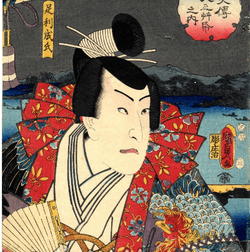Ashikaga Shigeuji

Ashikaga Shigeuji (足利成氏) (1438?–1497)[1] was a Muromachi period warrior and the Kamakura-fu's fifth and last Kantō Kubō (Shogun Deputy).[2] Fourth son of fourth Kubō Ashikaga Mochiuji, he succeeded his father only in 1449, a full decade after his death by seppuku. His childhood name was Eijuō-maru (永寿王丸).[3] His rule was from its onset troubled by hostilities with the central government: he was finally deposed in 1455 by shogun Ashikaga Yoshimasa, after which he escaped to Koga in Shimōsa Province, where he became known as Koga Kubō. There, he ruled until his death in 1497.
Biography
When in 1439 shogun Ashikaga Yoshinori attacked and invaded Kamakura, its ruler Mochiuji committed seppuku near today's Zuisen-ji to escape capture. His eldest son Yoshihisa, 14 years old at the time, was also forced to kill himself at nearby Hōkoku-ji.[4] His three younger sons however escaped to Nikkō and in 1440 were led by Yūki Ujitomo, head of the Yūki clan, to his castle in Koga, Shimōsa province, and survived.[5] When later Ujitomo's castle was attacked by the shogunate, they escaped. Two, Haruō-maru and Yasuō-maru, however were caught and executed, while Eijuō-maru survived.[6] Kamakura and the Kantō would then be ruled for the shogunate by the Uesugi clan until 1449.[7] In that year, Eijuō-maru's uncle Ōi Mochimitsu managed to have him appointed to the post of Kantō kubō (Shogun's Deputy in the Kantō region), the first Ashikaga to hold the post since his father's death ten years earlier.[5] On the occasion, the 11-year-old boy reached manhood and received the character Shige (成) for the adult name he was about to assume from shogun Yoshimasa himself (who took it from his former name, Yoshinari (義成)) and became Shigeuji.[8] Shogun Yoshimasa, not trusting Shigeuji, nominated his ally Uesugi Noritada kanrei with the task of keeping him informed of what happened in Kamakura. The relationship between the two men, already difficult because of the role the Uesugi had had in Mochiuji's death, was therefore strained from the beginning.[5][8] Tension culminated with Shigeuji's 1454 killing of Noritada, who was invited at Shigeuji's mansion and there murdered. The killing made the Kantō province fall into chaos because all Uesugi vassals rose against Shigeuji.[9] Imagawa Noritada defeated Shigeuji and Kamakura, and in 1455 Shigeuji had to flee to the friendly city of Koga, where in time he became known as the Koga kubō.[8] The Uesugi asked Yoshimasa to send someone to replace Shigeuji, so he sent his younger brother Masatomo with an army to pacify Kantō, but many vassals had remained faithful to Shigeuji, so Masatomo was unable to even enter Kamakura. He had to stop in Horigoe[10] in Izu Province, and was thereafter known as Horigoe Gosho. The Kantō therefore found itself with two rulers, one in Koga and one in Horigoe, neither of whom was able to rule.[7] The Kantō was, for all practical purposes, once again in the hands of the Uesugi.[7]
This was the beginning of an era in which the Kantō and Kamakura were devastated by a series of civil wars called the Sengoku period. War continued with on one side Masatomo and the Uesugi, on the other Shigeuji and the Chiba, the Utsunomiya, the Oyama and other clans. In 1471 Uesugi forces arrived in Koga, so Shigeuji had to escape to Chiba.[5] Hostilities ceased only in 1482. Shigeuji was able to return to Koga, where he founded a dynasty and ruled until his death in 1497.[8]
See also
| Preceded by Ashikaga Mochiuji |
The five Kantō Kubō Ashikaga Shigeuji 1449–1455 |
Succeeded by --- |
Notes
- ↑ According to the Kokushi Daijiten (see references) Shigeuji's date of birth used to be reckoned (on the basis of the Yūki Kassen-ki (結城合戦記) to be 1434 (date used for example by Papinot, see references) but is believed today to be 1438.
- ↑ The post would survive, but without real power.
- ↑ At the time in Japan a child received a temporary name (osanana, yōmei or yōmyō (幼名)), which would be later replaced by a definitive one.
- ↑ History of Kamakura (3) - Ashikaga Era, Kamakura Today, accessed on July 25, 2009
- 1 2 3 4 Papinot (1972:37-38)
- ↑ Kamakura Citizen's net - A Brief History of Kamakura accessed on August 2, 2009
- 1 2 3 Sansom (2000:241)
- 1 2 3 4 Kokushi Daijiten Vol. 10 (1983:162)
- ↑ See also the article Kyōtoku Incident
- ↑ Several sources, for example Sansom and Papinot, use the reading Horikoshi.
References
- Kokushi Daijiten Iinkai. Kokushi Daijiten (in Japanese). Vol. 10 (1983 ed.).
- Papinot, E. (1910). "Historical and Geographical Dictionary of Japan." 1972 Printing. Charles E. Tuttle Company, Tokyo, ISBN 0-8048-0996-8.
- Sansom, George (January 1, 1977). A History of Japan (3-volume boxed set). Vol. 2 (2000 ed.). Charles E. Tuttle Co. ISBN 4-8053-0375-1.